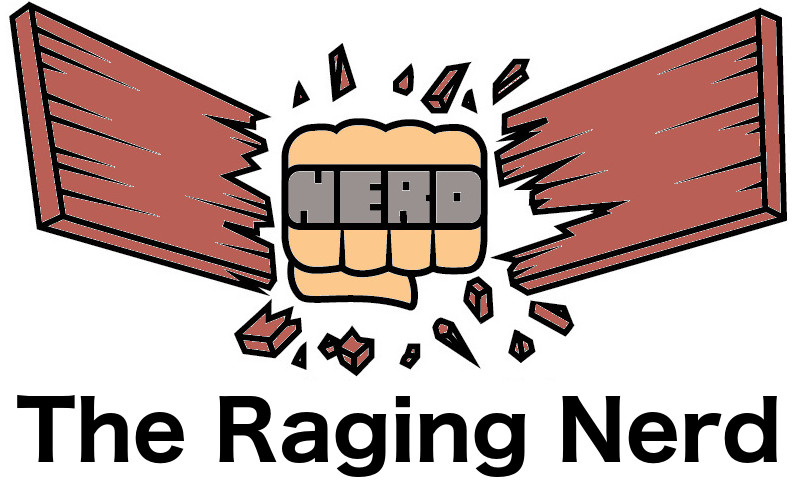Four Pokemon You Can Use On Mewtwo in Red/Blue
We all remember the old Pokemon games, Red and Blue. Later on, long before Gold and Silver shook things up with many new species, Yellow added to the fun by taking the ordinary model and adding many new features, such as a Pikachu that would follow you around. Although the balancing wasn’t perfect, the original Pokemon games were a unique experience and for many of us, were our first introduction to Nintendo. The Pokemon games are the reason so many people still wear Nintendo t shirts, or at least, one of the reasons. We all had a blast playing Pokemon and putting Pokemon posters on our walls..
But then there’s that little rascal, Mewtwo! It was obviously a lot of fun to play Mewtwo when you’re the one knocking enemy Pokemon around with zero effort. But suddenly, when you run into another player who is kicking your butt with their Mewtwo, it’s not fun anymore. The only real option is to pull out your own Mewtwo and go head-to-head, and that just gets boring after a while. So what are some non-Mewtwo Pokemon you can use to knock that sucker out? Is there any way to beat him without hauling out a long list of your own legendaries, or is he just invincible?
The first thing you could try is Parasect. I know what you’re thinking: “Parasect? That weak bug Pokemon? How in the world is he going to help me against Mewtwo?” Well, there is a specific moveset that you have to use. That moveset is as follows: substitute, spore, sword dance, mega drain. Start off by using spore to put Mewtwo to sleep. Then throw out a substitute and begin using sword dance to raise your attack. Finally, spam mega drain until big M2 bites the dust. The attack boost from sword dance, plus the bug-type bonus against psychics, ensures that mega drain will deal huge damage to Mewtwo. Even better, if Mewtwo wakes up and uses psychic to kill the substitute, you can just put him back to sleep with spore, which has a very high accuracy. On top of that, mega drain restores health to your parasect, so you can easily toss out another substitute once Mewtwo is sleeping again. If you can pull this off, there is nothing Mewtwo can do!The second thing you could try is Snorlax. The Snorlax moveset you want is amnesia, rest, headbutt, and selfdestruct. Simply use amnesia three times to begin with. This raises your special greatly so that Mewtwo’s psychic can’t knock you down. You can even rest and leave Snorlax out there for three rounds. His HP is so high he can weather three rounds of an angry Mewtwo, provided he has three amnesias under his belt. Then attack repeatedly with headbutt. Headbutt has the side effect of causing Mewtwo to flinch, which can open him up for another headbutt. Once Mewtwo’s hp is low enough, use selfdestruct for the KO.
Two final options are Dugtrio and Electrode. With Electrode, attack with thunderwave to paralyze Mewtwo, explosion to take a chunk from his HP, and then send out Snorlax. With Dugtrio, just use fissure repeatedly and hope for that one-hit KO.
George Lucas Returns!
Why is it such good news that George Lucas is returning to Star Wars? Why would it matter to the kind of person who watches all the movies and wears Star Wars t shirts? The reason is that George Lucas is the original force (or Force, if you will) behind the whole Star Wars franchise. He was the mastermind behind the original series, and his return triggers the hope for a return to form. With George Lucas back at the wheel, it is hoped that the original series, which lost its way a long time ago, will be back on top and ready to really inspire people and show true creativity in a way that the Disney-funded franchise did not.
Let’s rewind. George Lucas was the man behind the myth as far as Star Wars is concerned. The original creative genius behind the series was a man with very original ideas who was able to craft something the world had never seen. The Joycean, or perhaps Campbellian, genius behind the original Star Wars is something that could never be replicated by a committee or a focus group. It’s the kind of true creativity that nobody could replicate besides the original Jedi master himself.
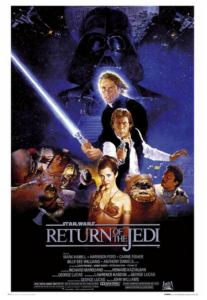 Then Lucas created the prequels, which weren’t as good. Now that nobody could tell George Lucas “no”, he was able to make all the self-indulgent creative mistakes he was prevented from making during the first trilogy. Because he was famous and well-known now, nobody dared to tell him “no”. Perhaps he surrounded himself with suck-ups, or perhaps it was mere happenstance, but George Lucas was now able to do whatever he wanted, and it ended up with an absolute mess of a prequel trilogy. This finally ended when he sold the franchise to Disney. This, it was thought, might repair the series.
Then Lucas created the prequels, which weren’t as good. Now that nobody could tell George Lucas “no”, he was able to make all the self-indulgent creative mistakes he was prevented from making during the first trilogy. Because he was famous and well-known now, nobody dared to tell him “no”. Perhaps he surrounded himself with suck-ups, or perhaps it was mere happenstance, but George Lucas was now able to do whatever he wanted, and it ended up with an absolute mess of a prequel trilogy. This finally ended when he sold the franchise to Disney. This, it was thought, might repair the series.
But that ended poorly, too. Once Disney got ahold of the series, it became democratized, corporatized, commodified, fed through focus groups and committees, a creature of bureaucracy. It was now a product, and not a product in the sense of a creation by an individual. Star Wars became something mass-produced, and that killed its appeal. It was one more politically correct franchise aiming to appeal to the lowest common denominator in a country with no unity and no common culture. It was a product for the masses, with no identity and no sense of exclusion or boundaries. It was simply a creative travesty.
With George Lucas back at the helm, we dare to hope for something better. We dare to hope that his self-indulgent tendencies have been fully attenuated, and that he will serve as a guide to take Star Wars back to creative validity. We want to see something new and exciting, not self-indulgent like the prequels and not a corporate mass-production like the latest films, but the true product of a creative mind. We want to see if George Lucas still has it in him. Let’s hope for the best. May the Force be with him.
Is Star Wars Actually Fantasy?
I once heard someone, a favorite author of mine on Quora, make an observation like this: “Sci-fi is about ideas, and fantasy is about spirituality.” This left me scratching my head at first. How in the world is something like Lord of the Rings about spirituality? And how is something like Star Trek about ideas? But the more I thought about it, the more I began to think that that guy was actually right. Sci-fi really is about ideas, and fantasy really is about spirituality. I thought long and hard, and I eventually came to a surprising conclusion: Star Wars is really fantasy, not sci-fi. The kind of guy who wears a Star Wars t shirt might disagree, but hear me out.
We all know that Tolkien is fantasy, right? And The Lord of the Rings really is about Tolkien’s spirituality. Tolkien was very Christian (he was Roman Catholic and devout) but also very pagan, in a way. There is something very deeply Norse about Tolkien’s worldview; his outlook on life has some of the pathos and tragedy of Norse mythology, but it’s wrapped in the hope (in fact, the certainty) of an ultimate triumph that comes from his Christian beliefs. CS Lewis is even more obvious. Michael Ende’s Neverending Story is an expression of Anthroposophy, which was a spiritual philosophy that he believed in.
Sci-fi is about ideas. Star Trek is the idea of utopia and how we can move closer to it. Dune is the idea of human potential being pushed to its limit. Michael Crichton’s books are about the abuse of technology and all the ways that that can become a problem. He was especially interested in the abuses of biotech. The difference is that sci-fi is much more analytical, much more rational and deductive, whereas fantasy is much more emotional and mythological. Fantasy can contain ideas, yes, but in a much more “blurry” way, not as clean cut or logical.
These two genres can be disguised as one another. What I mean is, there are a lot of so-called “fantasy” that is actually sci-fi, and a lot of so-called “sci-fi” that is actually fantasy. If you’re reading a book that looks like fantasy, but where there are definite rules of magic and systems in place, and where wizards do “research” to further their magic, then you’re looking at sci-fi disguised as fantasy. Those wizards are just physicists in pointy hats. Similarly, just as there are some fantasy franchises that are just disguised sci-fi, there are some sci-fi franchises that are actually disguised fantasy.
One of those is… Star Wars! I said earlier that fantasy is an expression of a person’s spirituality. I hazard a guess that George Lucas has a very particular view on this kind of thing. I don’t know anything about the guy, but if what I said about fantasy is true, then George Lucas probably has a very particular kind of spirituality to him, and that’s what is coming up in Star Wars. The Force almost seems like a concept out of Eastern religion! There is something vaguely Hindu or Buddhist about the themes expressed in Star Wars. So since fantasy is an expression of a person’s spirituality, I think it’s safe to say that Star Wars is fantasy.
The Stormtrooper Effect
If you’ve ever watched Star Wars, you may have noticed the the supposedly “feared” Imperial Stormtroopers are lousy shots. This is something that people in cinema of continuously commented on. You can look anywhere on the internet and see people complaining and joking about this. On forums and other websites, everybody cracks jokes about the Stormtroopers being unable to hit the broad side of a barn. This has become legendary, a trope, so to speak. In fact, at this point, it even has a name: the Stormtrooper Effect. The Stormtrooper Effect is not limited to just Star Wars, but is present in many other franchises.
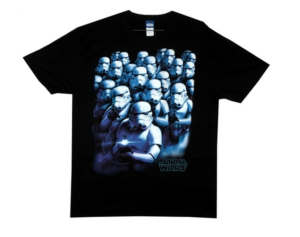 But why? Why would something so strange and ridiculous be so common? You’d think that such an unrealistic trope would have no place in most media, because if the audience doesn’t buy it, it won’t make any money. However, there’s more to it than that. You see, the Stormtrooper Effect is actually inevitable in any media where the heroes are fighting against hordes of mooks. Because if the mooks all had good aim, then the heroes would be dead at the beginning, and then there’d be no story. Not only is this not unique to Star Wars, it’s downright ubiquitous!
But why? Why would something so strange and ridiculous be so common? You’d think that such an unrealistic trope would have no place in most media, because if the audience doesn’t buy it, it won’t make any money. However, there’s more to it than that. You see, the Stormtrooper Effect is actually inevitable in any media where the heroes are fighting against hordes of mooks. Because if the mooks all had good aim, then the heroes would be dead at the beginning, and then there’d be no story. Not only is this not unique to Star Wars, it’s downright ubiquitous!
On top of that, you have to remember that the Stormtrooper Effect is not so unrealistic. In fact, it’s very, very realistic. Most soldiers who fire their weapons in war never actually hit an enemy. It takes hundreds of rounds fired on average for one kill to be scored. This is because the Stormtrooper Effect is actually a realistic depiction of how hard it is to hit a moving, intelligent human target who doesn’t want to be shot. If anything, the lack of realism flows in the other direction: it’s the heroes who have the unrealistic aim. Their aim is unrealistically good!
If you’re a big enough fan of the series to wear Star Wars t shirts, then you can probably point out some places where the Stormtrooper Effect doesn’t apply. For example, in the prequels, whenever a main character has a lightsaber that they can use to deflect blaster shots, the Stormtrooper Effect is no longer a problem. Now that the main character has a lightsaber to protect them and make sure they make it to the end (since they’re indispensable to the plot) the Stormtrooper Effect is no longer needed. It makes sense, and also provides a sense of realism because it shows that Stormtroopers do sometimes hit their targets, even if that target is a Jedi who can deflect the shots. That’s what you see on a Star Wars t shirt.
So the Stormtrooper Effect is ubiquitous because it has to be, but you can see some places where it doesn’t apply. Generally speaking, it helps to have some variety in fiction. Having the bad guys just miss is a default option for the writers. In order to mix things up a little, it helps to have other reasons for the heroes not to get shot.
What Is The Best Party Game?
Everybody has their own opinions about what constitutes a good party game or what games are best for parties and family gatherings. I think that if you’re just at a default party, with no especial theme or demographic, then the best board game for parties is Trivial Pursuit. There are a few things that make Trivial Pursuit stand out. Of course, everyone has their own specific tastes, but here’s why I think that Trivial Pursuit is the best. You can disagree with me if you want, but after reading this, you can not possibly deny that Trivial Pursuit is a fantastic party game. You might even like it enough to wear a Trivial Pursuit t-shirt!
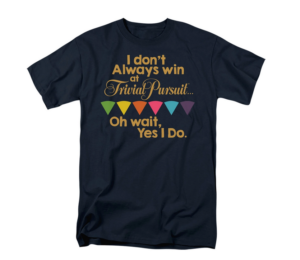 First of all, Trivial Pursuit can be played using teams or single players. There are several colors that can be used, so that makes it possible to have up to six people, each with their own colors. If you’re willing to have teams, then you can have up to twelve people, with each color corresponding to a pair of persons. Or, if you only have six people, you can just have three teams of two.
First of all, Trivial Pursuit can be played using teams or single players. There are several colors that can be used, so that makes it possible to have up to six people, each with their own colors. If you’re willing to have teams, then you can have up to twelve people, with each color corresponding to a pair of persons. Or, if you only have six people, you can just have three teams of two.
Second of all, Trivial Pursuit is knowledge-based. It’s not about skill at playing a particular game, like Splendor or Settlers of Catan or Carrcassonne. It’s also not about speed or how fast you can grab a piece or react to a bell ringing. Instead, Trivial Pursuit is about knowledge. You have to know the answers to the questions. And more importantly, there are enough different areas of knowledge to keep any single player from dominating the game. Even the egghead in your family will probably not excel at the sports section!
Third, Trivial Pursuit is very replayable. Unlike system-based strategy board games, such as Secret Hitler or Arkham Horror, Trivial Pursuit cannot really be “gamed”. You simply know the facts or you don’t. And since the game comes with so many cards, it’s always replayable.
Was Twisted Sister A Metal Band?
Twisted Sister is primarily known as a hair band, or hair-metal. It’s not true metal, but a kind of pop rock that was popular during the 1980s. However, they did have a few songs that were closer to true metal. While Twisted Sister primarily wrote songs that were poppy and anthemic, similar to Poison or Motley Crue, they did write a few songs that were less teased hair and leotards and more leather and spikes, more in the vein of Iron Maiden or Judas Priest than Whitesnake of Bon Jovi. So what songs were those, and what made them sound like metal?
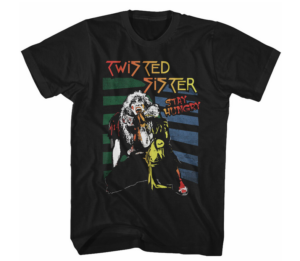 The first of their more metal tracks is Burn In Hell. The very title already sounds like a legitimate metal song rather than a hair metal bonanza, and that’s what they delivered on this track. Covered later on by no less a legendary black metal band than Dimmu Borgir, Burn In Hell begins with slow, ominous minor-key power chord riffing. The singer stays away from the higher end of his range and sings in a rough baritone: “Welcome to the abandoned lands/Come on in child, take my hand”. It’s the sort of singing that frequently accompanies heavier tracks in 80s metal. When he finally unleashes a high-pitched scream, the track kicks into overdrive, with the tempo increasing and the intensity ramping up. The chorus, a simple refrain of “You’re gonna burn in hell” serves to drive home the grim nature of the track. Interestingly, when viewed closely, the lyrics are not about Satan and death and evil at all. Rather, they’re a warning for the listener to change their ways before they “burn in hell”. Whether this is a reference to a literal Christian afterlife punishment, or a simple warning about the consequences of one’s actions, is anybody’s guess.
The first of their more metal tracks is Burn In Hell. The very title already sounds like a legitimate metal song rather than a hair metal bonanza, and that’s what they delivered on this track. Covered later on by no less a legendary black metal band than Dimmu Borgir, Burn In Hell begins with slow, ominous minor-key power chord riffing. The singer stays away from the higher end of his range and sings in a rough baritone: “Welcome to the abandoned lands/Come on in child, take my hand”. It’s the sort of singing that frequently accompanies heavier tracks in 80s metal. When he finally unleashes a high-pitched scream, the track kicks into overdrive, with the tempo increasing and the intensity ramping up. The chorus, a simple refrain of “You’re gonna burn in hell” serves to drive home the grim nature of the track. Interestingly, when viewed closely, the lyrics are not about Satan and death and evil at all. Rather, they’re a warning for the listener to change their ways before they “burn in hell”. Whether this is a reference to a literal Christian afterlife punishment, or a simple warning about the consequences of one’s actions, is anybody’s guess.
The second heavy track from Twisted Sister, which is the reason why so many metalheads still occasionally wear Twisted Sister t shirts, is Under The Blade. Under The Blade begins with fast palm mutes in a manner reminiscent of Judas Priest. The singer begins menacingly, saying, “A glint of steel, a flash of light/You know you’re not going home tonight”. At the end of the first verse, when he finally screams the word “Blade!” near the upper end of his range, the guitars go from fast low palm mutes to being ripped open by power chords higher on the fretboard. This is the sort of thing that Rob Halford would have had fun with. Amusingly, this song was highlighted by Tipper Gore as a reason to censor music and put parental advisory stickers on CDs, because she assumed that it was about lascivious, deviant practices. This is very funny, because Tipper Gore seems to have been projecting: in reality, Under The Blade is just about getting oral surgery, which is a very frightening experience, as anyone who has had their wisdom teeth out knows full well. Although it’s good that we all now know what Tipper Gore was doing on the weekends, if you get my drift.
What Does The Fallout Series Do For Us?
The Fallout games are a huge cash cow for Bethesda. For example, Fallout: New Vegas raked in more than three hundred million dollars in the first month after its release. Pause for a moment to reflect on what a tremendous sum of money that is. There are blockbuster films that never touch anywhere near that amount of money. How is it that this series has made Bethesda so much cash? What is it about Fallout that is so compelling that people just have to have it? Granted, it’s not the Elder Scrolls or the fame of Skyrim, but there’s definitely something there that people want. So what is it? What’s with all the Fallout video game shirts?
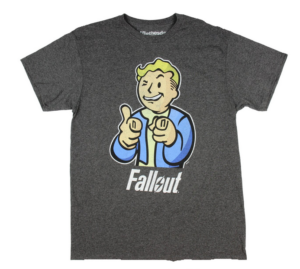 There are a few things. First of all, the post-apocalyptic genre is relatively underplayed. Yeah, there have been a few movies like Mad Max that had post-apocalyptic settings, but overall, it’s not a hugely popular genre. There are way more high fantasy and sci-fi/space opera settings than post-apocalyptic. Since it’s such an underused genre, Fallout comes across as a very original game by using a post-apocalyptic setting. Moreover, you would expect post-apocalyptic games to be either action or survival horror. Fallout, however, is decidedly a role playing game, which is unexpected and thus a fresh combination.
There are a few things. First of all, the post-apocalyptic genre is relatively underplayed. Yeah, there have been a few movies like Mad Max that had post-apocalyptic settings, but overall, it’s not a hugely popular genre. There are way more high fantasy and sci-fi/space opera settings than post-apocalyptic. Since it’s such an underused genre, Fallout comes across as a very original game by using a post-apocalyptic setting. Moreover, you would expect post-apocalyptic games to be either action or survival horror. Fallout, however, is decidedly a role playing game, which is unexpected and thus a fresh combination.
Secondly, it provides Bethesda with a series that is somewhat less cartoonish than their other games. Skyrim is an enormously popular game, but the voice acting, writing, and plot are all on the same level as you’d see in a Disney film, or perhaps slightly below that. The Fallout games just feel somehow more serious. Part of it is the superior quality of the voice acting and dialogue, as well as the writing. But another big part of it is the setting. While fantasy can be done well, it’s something that must be “sold” in order to be convincing. If we are going to take magical dragons seriously, then we have to be persuaded to do so. Post-apocalyptic settings are just easier to take seriously and lend themselves more to suspension of disbelief.
Another big issue with Fallout is the consistency of the series, which is an element that is missing from the Elder Scrolls. The Elder Scrolls was never a very consistent series. There was Arena, which was more of a beta or prototype than a series-launching game. Then we had Daggerfall, which is the first game that felt a bit like the Elder Scrolls but was still more of a historical achievement than a game that people still want to play today. The first really great ES was Morrowind, which was very different from Daggerfall. Oblivion felt like a more canned Morrowind with slightly better graphics, and Skyrim was just a straight-up action game.
Fallout, by contrast, is a very consistent series. That’s not to say that all the games are, or even feel, the same. However, they’re all clearly in the same genre and proceed along the same general lines. This is in stark contrast to the Elder Scrolls, which feel like a weird experiment with each new game. Fallout, by contrast, is a series where the gamer knows roughly what they’re going to get.
The Vulcan Salute
One of the interesting things about popular culture is that popular culture eventually just becomes culture. What starts off as a joke or a meme or a tv gag eventually finds its way into the common language. Many pop culture phenomena are ephemeral and eventually fade away. Today’s flavor of the week pop song fades away after a few months and that’s that. Maybe it gets a snippet of air play here and there. But some pop cultural phenomena endure and take on a life of their own, living far beyond the bands, franchises, and brands that gave them life.
 One of those pop cultural phenomena is the Vulcan salute. Go find a teenager who has never seen Star Trek and ask them if they recognize the hand sign with “Live long and prosper”. I’ll bet you anything that they do. That’s because Star Trek was such a good show that it wound up giving birth to many pop cultural phenomena that made it over the gap and became permanently part of our culture. One of the big contributions to the cultural lexicon from Star Trek is the Vulcan salute, a hand signal typically accompanies by the words “Live long and prosper.” You’ll see this gesture and its accompanying phrase on Star Trek t shirts.
One of those pop cultural phenomena is the Vulcan salute. Go find a teenager who has never seen Star Trek and ask them if they recognize the hand sign with “Live long and prosper”. I’ll bet you anything that they do. That’s because Star Trek was such a good show that it wound up giving birth to many pop cultural phenomena that made it over the gap and became permanently part of our culture. One of the big contributions to the cultural lexicon from Star Trek is the Vulcan salute, a hand signal typically accompanies by the words “Live long and prosper.” You’ll see this gesture and its accompanying phrase on Star Trek t shirts.
Believe it or not, the Vulcan salute was not created by the show’s writers. The writers of Star Trek did not conceive of the gesture, nor the words. Leonard Nimoy himself invented the gesture and put the words to it. Leonard Nimoy is Jewish and he based the gesture on something he saw Orthodox Rabbis doing when visiting an Orthodox synagogue as a child. He saw that they made a gesture where the ring and middle fingers were separated and the thumbs extended, and that they used this gesture when placing their hands on something to bless it. The hand position mimics the Hebrew letter “shin” which is short for one of the names of God in Hebrew. Nimoy created this gesture when he decided that the Vulcans were a race for whom the hand was very important.
The phrase “Live long and prosper,” while not sourced to any particular historical text, does have some antecedents. Various phrases in ancient Egyptian and medieval English literature have phrases that are not exactly the same as “Live long and prosper” but are fairly similar to it. “Live Long and prosper” is featured on many Star Trek t shirts.
Bizarro
One of the strangest supervillains and comics, not to mention one of the most unique entries in Superman’s rogues gallery. Many superheroes have a “doppelganger” sort of villain with whom they contend. Batman has Catwoman and Spiderman has Venom. Superman’s doppelganger nails the exact purpose of a doppelganger villain, which is to have a villain who possesses many of the hero’s strengths while simultaneously embodying everything he is not. Catwoman has Batman’s stealth, but is fickle versus Batman’s rationality. Venom has Spiderman’s powers but is brutish and destructive versus Spiderman’s soft-heartedness and Peter Parker’s modesty. Bizarro has many of the same powers as Superman, but is a hopeless troglodyte who runs directly counter to the high ideals that Superman holds. Bizarro is a villain frequently featured on Superman t shirts.
 Bizarro’s backstory changes, like all comic book characters, but there are some consistent themes. In most of the stories, he is the result of some kind of duplication experiment, such as a duplication ray. The general theme is that, whatever experiment accidentally creates him, Bizarro is an imperfect copy of Superman. He’s never quite the exact copy he’s supposed to be. This is why, whenever you see Bizarro, he seems to be stupid or speak in broken sentences. He is destructive, but in an oblivious sort of way. Very often, he seems to think that he is Superman. He doesn’t quite understand morality, either.
Bizarro’s backstory changes, like all comic book characters, but there are some consistent themes. In most of the stories, he is the result of some kind of duplication experiment, such as a duplication ray. The general theme is that, whatever experiment accidentally creates him, Bizarro is an imperfect copy of Superman. He’s never quite the exact copy he’s supposed to be. This is why, whenever you see Bizarro, he seems to be stupid or speak in broken sentences. He is destructive, but in an oblivious sort of way. Very often, he seems to think that he is Superman. He doesn’t quite understand morality, either.
And that’s another big part of his personality. Bizarro, in most incarnations, is not exactly evil. It’s more that he is immoral, because he does not understand the difference between right and wrong. In a way, Bizarro is, in fact, quite innocent. This is another part of his opposition to Superman: where Superman has a strong sense of justice and stands for certain principles, of which he is keenly aware, Bizarro has no principles at all. Bizarro doesn’t even have evil principles. He’s just amoral. He’s a bull in a China shop, not only in the sense of breaking things, but in the sense that neither Bizarro nor the bull know what they’re doing or are fully aware that they are breaking things.
Very often, especially in more recent treatments, Bizarro is dealt with relatively more gently than other villains. Superman often stops or imprisons him somehow without hurting him. Also, Bizarro frequently escapes to live on his own somewhere where nobody will bother him. In one of the earlier adaptations of his character, the duplicator ray the creates Bizarro is also used on Lois Lane. This creates a Bizarro Lois, who is immediately attracted to Bizarro. The two escape to make their own life elsewhere. This is in keeping with the strange innocence of Bizarro’s character. Because he does not know right from wrong, he implicitly does not deserve punishment or “justice” of the same kind that other villains do. Instead, Bizarro often finds himself being released or isolated in a way that protects him from the world as much as it protects the world from him.
What is Mega Man’s story?
Mega Man is a very recognizable video game character featured on many video game shirts. A lot of people know who he is even if they’ve never played any of the games. Released in the late 1980s, the first Mega Man game was revolutionary because it allowed the player to choose what order to defeat the bosses in. Each boss gave the player a new weapon to use, which would be very effective against at least one other boss. For example, an ice-themed boss might give you a weapon that works well against the fire boss. Choosing which boss to beat and in what order made the original game stand out.
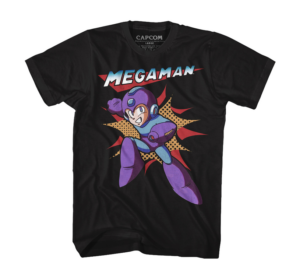 But what was the story of Mega Man? In the original game, the robot (originally known as Rock Man) was a robot created by a scientist named Dr. Light. Dr. Light had a colleague named Dr. Wiley who helped created robots. When Dr. Wiley went rogue and reprogrammed Dr. Light’s robots, one of the only ones who escaped was Rock Man, who offered to be converted into a combat robot to stop Dr. Wiley. This was a simple enough story, and Dr. Wily was the boss of the original game. He was one of those old style video game bosses that is beaten in several stages.
But what was the story of Mega Man? In the original game, the robot (originally known as Rock Man) was a robot created by a scientist named Dr. Light. Dr. Light had a colleague named Dr. Wiley who helped created robots. When Dr. Wiley went rogue and reprogrammed Dr. Light’s robots, one of the only ones who escaped was Rock Man, who offered to be converted into a combat robot to stop Dr. Wiley. This was a simple enough story, and Dr. Wily was the boss of the original game. He was one of those old style video game bosses that is beaten in several stages.
This was a short lived part of the whole mythos, though. A few years later, in 1993, the character who would come to truly define the series was created. The character’s name was X, although he is commonly also called Mega Man. X is a successor to the original Mega Man that was created and placed in suspended animation for a century before being recovered by Dr. Cain. He was originally created by Dr. Light, but Dr. Cain was the scientist who found him a century later. Ignoring Dr. Light’s warnings that were logged in the time capsule, Dr. Cain proceeded to replicate Mega Man and create many more robots like him, called Reploids.
The Reploids (replica androids) were different from their predecessors. Like Mega Man X, they had free will and could make their own decisions. Disaster struck when a certain group of them became known as “mavericks”, turning against their human masters with their newfound free will. A group of maverick hunters was created, consisting of loyal reploids who could hunt down and kill the mavericks. One such maverick hunter was called Sigma. Sigma was originally a maverick hunter, but he eventually became a maverick himself and becomes the main villain of Mega Man X. Another character is introduced, named Zero, who is like the opposite of Sigma: originally a creation of Dr. Wily, he joins the maverick hunters later on.
The plot becomes more complicated from there, of course, but the brass tacks of it have been laid out. The plot as a whole is very confusing for a newcomer to the series, so if you don’t want to sound like a fool in front of die-hard fans, this article should help you out.
